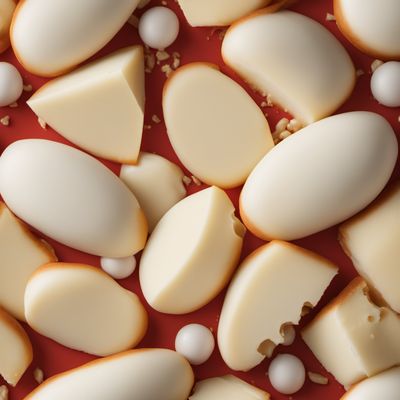
Ingredient
Cheese, tilsit
The Melting Marvel: Tilsit Cheese
Tilsit cheese is a semi-hard cheese with a pale yellow interior and a natural rind. It has a creamy and slightly tangy taste, with hints of butter and nuts. The texture is smooth and supple, becoming more crumbly as it ages. Tilsit cheese is often compared to Swiss or Gouda cheese, but it has its own unique characteristics.
Origins and history
Tilsit cheese originated in the town of Tilsit, which is now part of Russia. It was first made in the 19th century by Swiss settlers who brought their cheese-making traditions to the region. The cheese gained popularity and spread throughout Europe, eventually reaching other parts of the world. Today, it is produced in various countries, including Germany, Denmark, and the United States.
Nutritional information
Tilsit cheese is a good source of protein and calcium. It also contains vitamins A and B12. However, it is high in saturated fat and sodium, so it should be consumed in moderation.
Allergens
Milk (including lactose), N/A
How to select
When selecting Tilsit cheese, look for a cheese with a pale yellow interior and a natural rind. The cheese should have a slightly tangy aroma. Avoid cheeses with any signs of mold or excessive dryness. Opt for cheeses that are made from high-quality milk and produced by reputable cheese makers.
Storage recommendations
To keep Tilsit cheese fresh, store it in the refrigerator in its original packaging or wrap it tightly in plastic wrap. It is best consumed within a week of purchase. To prevent the cheese from drying out, place a damp paper towel in the storage container or wrap.
How to produce
Tilsit cheese is typically produced by professional cheese makers using specialized equipment and techniques. However, adventurous home cooks can try making their own version using recipes and guidance from experienced cheese makers or cheese-making kits available in the market.
Preparation tips
Tilsit cheese can be enjoyed on its own or used in various dishes. It melts well, making it a great choice for grilled cheese sandwiches, burgers, or fondue. It can also be grated and used as a topping for salads, pasta, or soups. Tilsit cheese pairs well with fruits, such as apples or pears, and goes well with crusty bread or crackers.
Substitutions
Gouda cheese, Swiss cheese
Culinary uses
Tilsit cheese is commonly used in European cuisines, particularly in German and Danish dishes. It is often used in sandwiches, salads, and hot dishes, adding a creamy and tangy flavor. It is also a popular choice for cheese boards and charcuterie platters.
Availability
Germany, Denmark, Russia
More ingredients from this category » Browse all

Cheese, asiago
"Aged Delight: Unveiling the Richness of Asiago Cheese"

Cheese, bra
Bra Cheese: A Savory Delight

Cheese, edam
The Dutch Delight: Edam Cheese

Cheese, appenzeller
The Swiss Delight: Appenzeller Cheese

Cheese, nokkelost
"Nokkelost: The Spiced Delight of Scandinavian Cheeses"

Cheese, podlaski
The Delightful Polish Cheese

Cheese, bundnerkase
The Alpine Delight

Cheese, sao jorge
The Azorean Delight

Mozzarella cheese (specific for pizza)
The Melting Marvel: Mozzarella Cheese for Perfect Pizza

Cheese, colby
"Colby Cheese: The Creamy Delight with a Mild Twist"

Cheese, cantal
The Versatile Delight: Cantal Cheese

Cheese, scamorza
Smoky Delight: Unveiling the Secrets of Scamorza Cheese